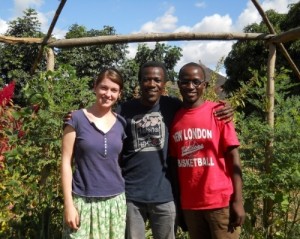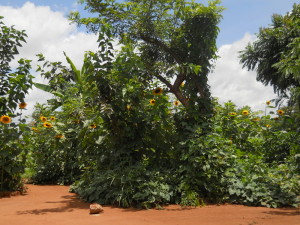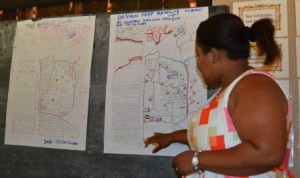
(image courtesy of www.abigailconrad.com)
In one of the most extensive studies ever done–to date–on the implementation of Permaculture practices in Malawi, researcher Abigail Conrad has just released the results of her Doctoral dissertation entitled, “We Are Farmers: Agriculture, Food Security, and Adaptive Capacity Among Permaculture and Conventional Farmers in Central Malawi”.
Ms. Conrad (now Dr. Conrad) conducted her research in Malawi from September 2011 to July 2012 with the aim of evaluating “the impacts of using permaculture by comparing the agricultural practices and food security of smallholder conventional farmers to farmers who use permaculture.” The study takes an in-depth look at Malawi’s agricultural history, exposes several drawbacks to current ‘conventional’ agriculture practices, highlights many benefits that local farmers identified through their practice of Permaculture, and gives a realistic analysis of the challenges facing the expanded uptake of Permaculture in Malawi.

(image courtesy of www.abigailconrad.com)
This study is exciting and encouraging in many ways. First, there has been a glaring lack of academic research surrounding the use of agroecological approaches, such as Permaculture. One of the reasons for this disparity is highlighted in Conrad’s paper where she writes: “Anthropologists Veteto and Lockyer state that permaculture “has largely been ignored” in academia generally, and in anthropology specifically, because it was developed when discrete disciplinary approaches were well not suited to address the holistic approach of permaculture (2008:49).” Conrad also states that: “Further, permaculture challenges how governments and NGOs usually teach people to farm. Scientists, governments, and agribusinesses have devalued and eroded indigenous farming knowledge, like that used in permaculture, with the imposition of monocropping and Green Revolution technologies.”
Secondly, Conrad’s findings help to highlight some of the benefits that Permaculture farmers are already experiencing through the implementation of sustainable design systems. Interestingly, the majority of Conrad’s research took place during a highly economically unstable period in Malawi, and yet Permaculture farmers continued to express gains and benefits. She writes: “Further, the permaculture farmers experienced the benefits discussed during an abnormal time of political, economic, and environmental stress and shocks. In 2011-2012, the economy was unstable because of limited foreign currency due to donors withholding aid funds and low global tobacco prices, which led to higher food prices, inflation, imported fuel shortages, decreased fertilizer imports, and sugar shortages (Dionne, Kramon, and Roberts 2013:14; Wroe 2012:139)…These broader factors negatively affected household livelihoods; however, these problems did not prevent permaculture farmers from experiencing benefits.” Again, from the paper: “My primary findings suggest that permaculture farmers experienced multifaceted benefits from implementing permaculture because the farmers used permaculture practices that addressed specific household constraints and expanded their adaptive capacity.”
More information regarding Conrad’s research, methodologies, findings, and recommendations can be found by visiting her website at AbigailConrad.com
To highlight some of the most interesting and promising aspects of Permaculture implementation in Malawi, we will let the study speak for itself. Here are a few quotes from the paper:

- “This analysis showed that farmers who used permaculture experienced agricultural, environmental, livelihood, and food and nutrition security benefits in comparison to farmers who solely used conventional agriculture.”
- “The permaculture farmers reported agricultural benefits that resulted from growing more varieties of crops, intercropping, and using soil and water conservation techniques.”
- “On average, permaculture farmers grew three times more crops overall, and more crop varieties per food group than conventional farmers.”
- “In practice, permaculture plots in Malawi are often organic, low-input, and biodiverse, and farmers used techniques like intercropping, planting trees and perennials, and resource recycling.”
- “There was variation between households, however, permaculture farmers reported a range of agricultural, environmental, livelihood, and food and nutrition security benefits related to the agricultural practice changes they made with permaculture implementation. For example, permaculture farmers had higher agrobiodiversity and lower purchased input requirements on average compared to conventional farmers. In addition, the permaculture farmers all reported improvements in food access since beginning to use permaculture. Permaculture farmers also on average had higher food security and diet diversity scores than conventional farmers.”
- “The applications, dissemination, and credibility of permaculture have grown in Malawi since the mid-1990s, with organizations using permaculture in all regions of the country. A report from the UN Special Rapporteur on the right to food, after visiting Malawi in 2013, mentions that “permaculture vegetable and fruit gardens, which are vital for food security and nutrition, could be disseminated more broadly” (De Shutter 2013).”
- “The permaculture design system includes different techniques than conventional agriculture and has a unique history. The design system focuses on agroecology and systems design, which the social movement, education, and permaculture organizations promote.”
- “Permaculture farmers’ practices involved more than adopting a new farming practice like using manure, tree planting, or intercropping beans with maize, as some other sustainable agricultural development programs in Malawi focus on. They used the skills-based permaculture system to alter agricultural, resource, and land management practices, in addition to applying a degree of systems thinking by using the design system.”
- “Conventional farmers had limited ability to apply conventional techniques given their cost and conventional techniques did not improve their farm system in the long term. Permaculture farmers faced the same overall problems as conventional farmers, however, permaculture education and practices expanded farmers‟ skills and available strategies to contend with some constraints and improvise in response to problems. Permaculture farmers also faced social challenges and material, environmental, and knowledge constraints when implementing permaculture. However, farmers were able to use permaculture practices in a way that provided them with agricultural, environmental, and livelihood benefits.”
- “Learning permaculture gave farmers tools to improve their food access. As permaculture education opened new possibilities for ways to farm, it expanded the food consumption choices available to farmers. Permaculture farmers altered their food practices and cooking to a degree in response to improved food access.”
- “My primary findings suggest that permaculture farmers experienced multifaceted benefits from implementing permaculture because the farmers used permaculture practices that addressed specific household constraints and expanded their adaptive capacity.”
- “The multi-functional benefits farmers experienced from using permaculture supports the growing call for “triple-win solutions” for agriculture, health, and environmental sustainability by donors and policy-makers that promote low external agriculture (IFPRI 2013a:13).”
- “Similarly, learning about permaculture has helped to widen the set of knowledge and tools at farmers‟ disposal, and therefore the options available to them, to make changes to their agricultural production and to solve a host of associated problems.”
- “For example, the permaculture ethic of equitably sharing surplus resources that the permaculture organizations promoted helped to support local community norms of sharing and reciprocity. More generally, as a type of social learning, permaculture education involves farmer-to-farmer learning and promotes local knowledge, which can potentially build community capacity, strengthen relationships of reciprocity, and expand knowledge sharing (Pretty and Smith 2004:637; Altieri and Toledo 2011:588–589).”
- “The differences between conventional and permaculture farming, and the challenges and benefits of using permaculture have implications for the development sector and the permaculture movement. For the development sector, the research findings point to the potential value of skill-based approaches to agricultural development and food-based approaches to food and nutrition security.”
- “Malawians’ reliance on maize contributes to food insecurity and malnutrition due to annual maize shortages and inadequate diet diversity (WFP 2012:41; Yeudall et al. 2007; Lin et al. 2007; Dickinson et al. 2009:3).”
- “Although most Malawian farmers are smallholders, the government, tobacco leaf companies, agribusiness, donors, NGOs, and civil society organizations make up the dominant players, and often beneficiaries, in the agriculture sector according to development studies scholar Chinsinga (2011b:59). These actors primarily promote conventional agriculture technologies, such as hybrid seeds, chemical fertilizers, pesticides, and irrigation (Chinsinga 2011b; Bezner Kerr 2010:104).”
- “Foreign corporations sell the bulk of agricultural inputs in Malawi, offering farmers‟ limited input options (Chinsinga 2011b:60–61; Holden and Lunduka 2010; Bezner Kerr 2012:224). US-based Pannar (now part of DuPont) and Monsanto and Zimbabwean-based Seed Co. dominate the commercial seed market in Malawi.”
- “Conventional agriculture development work, such as that supported by the Alliance for a Green Revolution in Africa, the New Alliance for Food Security and Nutrition, and Malawi’s Farm Input Subsidy Program, often supports the economic interests of companies and economies in the global North at the expense of environmental sustainability and smallholder farmers‟ economic and food sovereignty (Bezner Kerr 2012; Altieri and Toledo 2011).”
- “Some farmers can access fertilizer and hybrid maize seed inputs at a highly subsidized rate through FISP, but the program does not provide enough inputs for farmers, is fiscally unsustainable, and emphasizes maize production (MAFS 2007:xvii). Farmers use these inputs to contend with environmental problems in the present; however, input use is not a sustainable coping strategy and does not address the underlying problems of soil infertility and inadequate rainfall that make them necessary on an ongoing basis. In addition, these inputs are primarily used to increase maize yields, which fails to address the issues of food quality and malnutrition associated with predominately maize-based diets (GFDRR 2011; Oxfam International 2009; Pinstrup-Andersen 2010; Bezner Kerr 2012). Indeed, despite a national maize surplus since 2007/08 after FISP implementation in 2005/06, there was an increase in rural poverty and food insecurity in 2011/12 (IFPRI 2013b:2).”
- “The utility of permaculture, as a complex design system, is a reminder that development projects can be multifaceted, complex, and flexible, while still being feasible and effective. I argue that along with other structural interventions, permaculture is a strategy that donors and development practitioners should consider incorporating in livelihood, food and nutrition security, and agricultural development programs.”
- “In addition, permaculture use has the potential to contribute multifaceted impacts of nutrition-sensitive agricultural programs for households.”
- “Broadly, the findings of this study suggest that smallholder farmers can benefit from using permaculture and the permaculture model for social change and development may have limited impacts.”
- “Permaculture education improved farmers‟ adaptive and improvisational capacity to respond to problems and shocks within unpredictable and vulnerable conditions by helping to expand the options they had to solve or cushion problems.”
- “The fact that permaculture is not dependent on access to money created options for the farmers who learned about and used permaculture. Their expanded skill set increased the options available to them for how to farm, and the changes in farming led to increased food consumption choices. These changes affected farmers beyond material benefits, because food insecurity and impoverishment lead to other forms of suffering such as stress, malnutrition, disease, and death in some cases.”
- “Amayi Sesani aptly summarized her perception of the difference between resource use in conventional agriculture and permaculture. She said, “Ahh, this ongoing [permaculture] farming, and this type of [conventional] farming that we are seeing nowadays, there is indeed a difference. This other [conventional] type needs more energy from a person each and every time, and also it needs more inputs. While the permaculture one does not count whether I am rich or I am poor. Everyone can use it well,” she emphasized.”
Related research papers include:
Potential of Permaculture, by Abigail Conrad
The Over-Consumption of Maize, by Abigail Conrad
Permaculture Adoption Among Malawian Farmers: A Positive Deviance, by Hope Thornton
Food Insecurity in Malawi: Do Agricultural Input Subsidies Actually Address Hunger?, by Andy Currier
